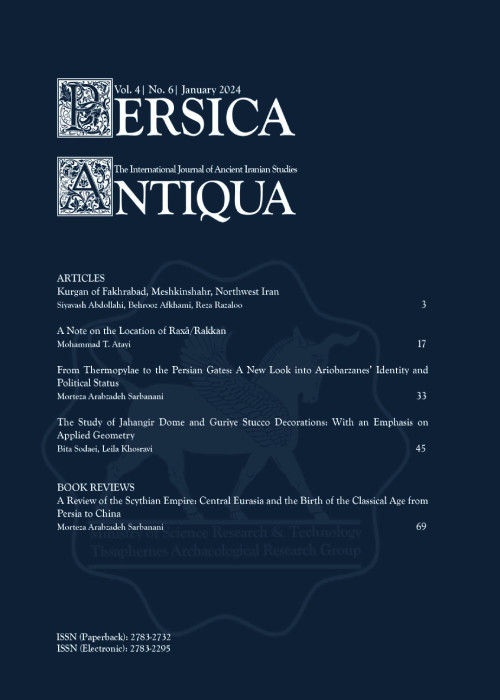فهرست مطالب

Persica Antiqua
Volume:4 Issue: 6, Jan 2023
- تاریخ انتشار: 1402/10/11
- تعداد عناوین: 5
-
-
Pages 3-15Notwithstanding its cultural wealth, archaeologists have hitherto given little consideration to Meshkinshahr County of Iran’s Ardabil Province. The region is remarkably rich in graves, as is evident from the various types of graves with simple inhumation, dolmen, rectangular stone-built, and Kurgan. In the spring of 2019, a rare example of Kurgan was investigated near the city of Fakhrabad. Unlike all other graves excavated in northwest Iran, its structure consisted of a combination of stones and mud bricks. This paper presents the preliminary results from the excavation of this Kurgan. While introducing the Kurgan, an assemblage of small artifacts and its structure were examined, and a relative chronology was then proposed. The Kurgan arguably occupies a special place in archaeology of Iran and South Caucasus given a combination of stones with mud bricks it has in its construction. Such Kurgan type still remains unreported from the region.Keywords: Northwest Iran, Kurgan, Mudbrick, Iron Age
-
Pages 17-31
A number of candidates in the Kor River Basin, Fars, Iran, have previously been proposed for the location of the ancient Raxā/Rakkan a town mentioned in the Bisotūn Inscription and in the Persepolis Fortification Tablets. None of these suggestions, however, is convincing. Based on textual evidence, archaeological observations, and the local environmental conditions, the present study suggests that ancient Rakkan should be identified with the archaeological site of Kal Abdi in the southern part of the Baizā Plain.
Keywords: Achaemenid, Fars, Kor river basin, Baizā, Rakkan -
Pages 33-44Diodorus Siculus, Quintus Curtius Rufus, Polyaenus, and Arrian are the primary historians who have written about the Battle of the Persian Gates but their accounts differ in some details. Much research has been done on the cause of differences between these historians, their method of historiography as well as their sources; but in this article, the main focus has been on the identity and political status of Ariobarzanes, the general who led the Persians in the aforementioned battle. As this essay argues, the clarification of this issue hinges on a large extent understanding Ariobarzanes’ end at the Persian Gates. Of course, due to discrepancies between classical sources and the absence of any Iranian evidence in this regard, this is not an easy task, but this article tries to find the most reasonable answer by identifying the most accurate classical account, and then presents essential historical results to be drawn from it. It should be noted that so far, various researchers, have speculated on the identity of Ariobarzanes with skepticism, but in this article, with detailed criticism of classical resources, the identity and political status of Ariobarzanes are clarified.Keywords: Ariobarzanes, Persian Gates, Alexander the Great, Arrian, Quintus Curtius Rufus, Diodorus Siculus, Polyaenus
-
Pages 45-68This paper tries to survey the use of geometric patterns in stucco decorations as an important identity and cultural element in the Sasanian era building designs. Seven frieze patterns were used in order to understand the practical geometry in Sasanian stucco. The studied stuccoes were found during archaeological excavations conducted between 2015 and 2017 at e Jahangir Dome and Guriye Stuccos in Eivan, Ilam province. In this article, the discovered stuccoes have been examined, results of which indicate that stuccoes can be divided into three categories based on their features and applications: geometric patterns, vegetal patterns, and animal patterns. Comparing these stuccoes with those found elsewhere such as Qale Yazdegerd, and Ctesiphon shows that the buildings of Jahangir Dome and Guriye were noble houses in the Sasanian period, with their vegetal motifs and mythological animals being e formed under the influence of religious and ritual elements. The survey of motifs on the base with seven frieze patterns shows artists’ adherence to the principle of symmetry and repetition.Keywords: Sasanian, Stucco, Symmetry, repetition, Geometric
-
Pages 69-77The Scythian Empire is a controversial book with a charming title that can attract the attention of any scholar. Christopher I. Beckwith presents claims in this book that accepting each one of them leads us to rethink many previous customary historical beliefs. Some of his theories are novel but most of them are rehabilitation of older obsolete ideas. The book wraps a wide range of specialized topics in the fields of history, archeology, and linguistics; but deals with most of them on a superficial level. Since the Scythians were an Iranian ethnic group, this work is especially recommended for scholars of Iranian history, as unfortunately, the significance of the Scythians in shaping Iranian history has not been recognized as other ancient Iranians such as the Persians. In a broader sense, this work can be also useful for scholars interested in the Iranian world and its relations with neighboring civilizations, Eurasia, Central Asia, and China.Keywords: Iran, China, Eurasia, The Scythians, The Persian Empire

